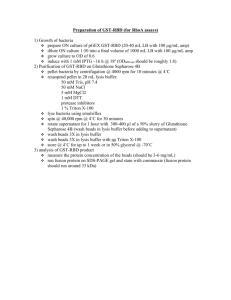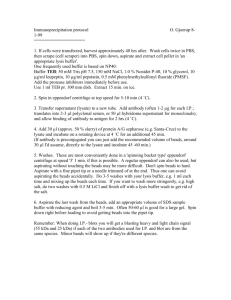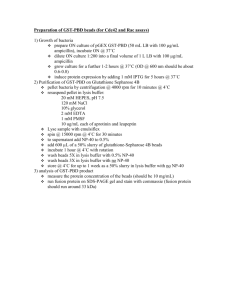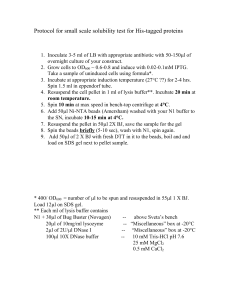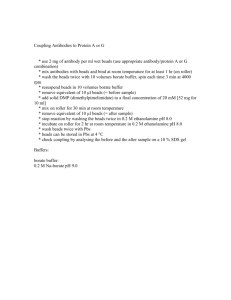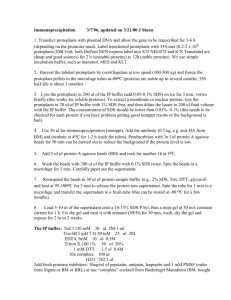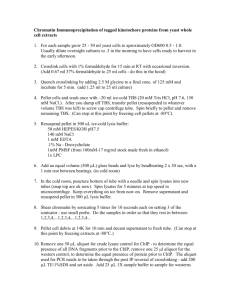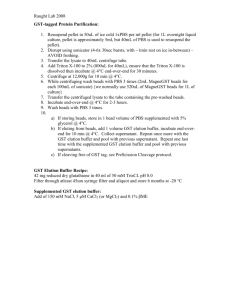Immunoprecipitation protocol General immunoprecipitation procedure
advertisement
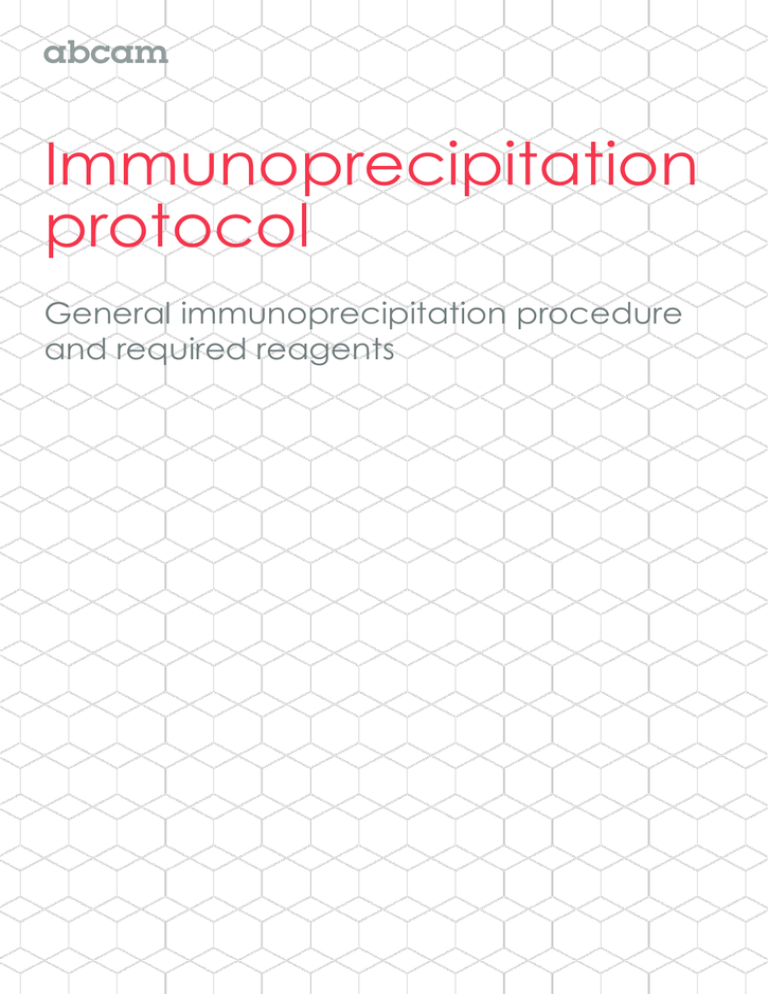
Immunoprecipitation protocol General immunoprecipitation procedure and required reagents Immunoprecipitation protocol Contents – – – – – – – – – Lysis buffers Other reagents Preparing the lysates Pre-clearing the lysates Immunoprecipitation Washing Elution Choosing the correct beads – summary table References Lysis buffers The ideal lysis buffer will minimize protein denaturation while releasing an adequate amount of proteins from the sample. Non-ionic detergents such as NP-40 and Triton X100 are less harsh than ionic detergents such as SDS and sodium deoxycholate. Other variables that can affect the success of immunoprecipitation include salt concentration, divalent cation concentration and pH. To optimize the variables, they should be tested within the following ranges (from Harlow and Lane, page 231): – – – – – – Salts: 0–-1 M Detergent, non-ionic: 0.1–2% Detergent, ionic: 0.01–0.5% Divalent cations: 0–10 mM EDTA: 0–5 mM pH: 6–9 Non-denaturing lysis buffer Use for antigens that are detergent soluble and are recognized in native form by the antibody. Triton X-100 can be substituted for NP-40. – – – – 20 mM Tris HCl pH 8 137 mM NaCl 1% Nonidet P-40 (NP-40) 2 mM EDTA Store up to 6 months at 4°C. Immediately before use add protease inhibitors. For convenience, a 10% sodium deoxycholate stock solution (5 g into 50 mL) may be prepared. It must be protected from light. 2 Detergent-free soluble protein lysis buffer Some soluble proteins may not require use of detergents. Use this buffer with mechanical cell lysis such as homogenization with a Dounce homogenizer. PBS containing: – – 5 mM EDTA 0.02% sodium azide Store up to 6 months at 4°C. Immediately before use add protease inhibitors. Denaturing lysis buffer for non-detergent soluble antigens Epitopes of native proteins are not accessible to antibodies that only recognise denatured proteins. When harvesting and lysing the cells, heat the cells in denaturing lysis buffer. This method can also be used for antigens that cannot be extracted from the cell with non-ionic detergents. Use of DNase1 will aid extraction of proteins from chromatin. – – 1% SDS 5 mM EDTA Store up to 1 week at room temperature. Immediately before use add – – 10 mM dithiothreitol or beta-mercaptoethanol Protease inhibitors15 U/mL DNase1 Wash buffers – 10mM Tris; adjust to pH 7.4 – 1mM EDTA – 1mM EGTA; pH 8.0 – 150mM NaCl – 1% Triton X-100 – 0.2mM sodium orthovanadate – Protease inhibitor cocktail Store up to 6 months at 4°C. Immediately before use add protease inhibitor. 3 Immunoprecipitation protocol Other reagents Protease inhibitors Proteolysis, dephosphorylation and denaturation begin as soon as cells are lysed. Putting samples on ice will slow down these processes, but protease and phosphatase inhibitor cocktails are also available. If not using a cocktail, PMSF (50 μg/mL) and aprotinin (1 μg/mL) are protease inhibitors commonly used for immunoprecipitation. Other reagents – Sterile PBS pH 7.4 – Sterile PBS-BSA 1% w/v (filtered) – TBST buffer – Loading/sample buffer for western blotting – VeriBlot for immunoprecipitation secondary antibodies, which preferentially detect the non-reduced, non-denatured primary antibody during western blotting. – 100 mM EDTA stock solution is made with 1.86 g EDTA dissolved into 40 mL H 2O. Add NaOH to adjust the pH to 7.4. Finally, adjust the total volume to 50 mL. Preparation of lysates Lysates from cell culture (non-denaturing) 1. Place the cell culture dish on ice and wash the cells with ice-cold PBS. 2. Drain the PBS, then add ice-cold lysis buffer (1 mL per 107 cells/100 mm2 dish/150 cm2 flask; 0.5 mL per 5x106cells/60 mm2 dish or 75cm2 flask). 3. Scrape adherent cells off the dish using a cold plastic cell scraper then gently transfer the cell suspension into a pre-cooled microcentrifuge tube. 4. Maintain constant agitation for 30 min at 4°C. 5. Centrifuge in a microcentrifuge at 4°C. You may need to vary the centrifugation force and time depending on the cell type. A guideline is 20 min at 12,000 rpm but you should optimize this for your specific experiment (eg leukocytes need a very light centrifugation). 6. Gently remove the tubes from the centrifuge and place on ice. Aspirate the supernatant and place in a fresh tube kept on ice, and discard the pellet. 4 Lysates from cell culture (denaturing) 1. Add 100 μL denaturing lysis buffer to 0.5–2x107 cells. 2. Mix well by vortexing vigorously for 2–3 sec at maximum speed. Transfer the cell suspension to a microcentrifuge tube. The solution can be viscous at this stage due to release of DNA. 3. Heat samples to 95°C for 5 min to denature. 4. Dilute the suspension with 0.9 mL non-denaturing lysis buffer. Mix gently. The excess 1% Triton X-100 in the non-denaturing lysis buffer quenches the SDS in the original denaturing buffer. 5. Fragment the DNA by passing the lysed suspension 5–10 times through a needle attached to a 1 mL syringe. Repeat mechanical disruption until the viscosity is reduced to manageable levels. If the DNA is not fully digested and fragmented, it can interfere with the separation of the pellet and supernatant following centrifugation. 6. Incubate on ice for 5 min. 7. Proceed with the immunoprecipitation Lysates from tissue 1. Dissect the tissue with clean tools and as quickly as possible. If possible, do this on ice to prevent degradation by proteases. 2. Place the tissue in round-bottom microcentrifuge tubes and immerse in liquid nitrogen to snap freeze. Store samples at -80°C for later use or keep on ice for immediate homogenization. 3. For a ~5 mg piece of tissue, add ~300 μL lysis buffer rapidly to the tube and homogenize with an electric homogenizer. 4. Rinse the blade twice with another 300 μL lysis buffer per rinse and then maintain constant agitation for 2 h at 4°C (eg place on an orbital shaker in the refrigerator). Volumes of lysis buffer must be determined in relation to the amount of tissue present. Protein extract should not be too dilute to avoid loss of protein and to minimize the sample volume to be loaded onto gels. The minimum concentration is 0.1 mg/mL; optimal concentration is 1–5 mg/mL. If denatured samples are required, use denaturing lysis buffer and perform Steps 2–5 from the denaturing protocol above. 5. Centrifuge for 20 min at 12,000 rpm at 4°C in a microcentrifuge. Gently remove the tubes from the centrifuge and place on ice, aspirate the supernatant and place in a fresh tube kept on ice. Discard the pellet. 5 Immunoprecipitation protocol Pre-clearing the lysates Pre-clearing the lysate can help reduce non-specific binding and reduce background. However, if the final detection of the protein is by western blotting, preclearing may not be necessary unless a contaminating protein is interfering with visualization of the protein of interest. 1. Add either 50 μL of off-target antibody of the same species and isotype as the immunoprecipitation antibody, or normal serum (rabbit is often preferred, see Harlow and Lane, page 243) to 1 mL of lysate. Incubate for 1 h on ice. 2. Add 100 μL of bead slurry to the lysate. 3. Incubate for 10–30 min at 4°C with gentle agitation. 4. Spin in microcentrifuge at 14,000 x g at 4°C for 10 min. 5. Discard bead pellet and keep supernatant for immunoprecipitation. To increase the yield, the beads can be washed 1 or 2 more times in lysis buffer, and the supernatants collected together. It is important to make sure that as much of the normal serum is removed as possible, as this will compete with the antibody against the antigen of interest. To check for this, a test can be done with lysis buffer instead of sample, performing all pre-clearing steps as above. Running a gel of the resulting supernatant and staining with Coomassie will reveal if the serum Ig is being removed effectively. If serum has not been sufficiently removed, bands will be present at 50 and 25 kDa for heavy and light chains; its presence may contribute to a weak immunoprecipitation. Consider either decreasing the amount of serum or increasing the amount of beads incubated with your samples in the preclearing step. 6 Immunoprecipitation protocol Immunoprecipitation There are a few different methods to immunoprecipitate proteins. The first approach (Method A) is to mix antibody with protein sample, followed by addition of Protein A/G support. This method yields high purity of protein; however, the antibodies are also co-eluted with protein of interest which sometimes creates difficulties in western blot detection. The second approach (Method B) is to bind antibody to the Protein A/G beads and then mix with the antigen. This method gives lesser yield than the first one, but avoids the problem of co-elution of antibodies. Method A Immunoprecipitation with antibodies in solution: 1. On ice, in a microcentrifuge tube add 10–50 μg cell lysate plus the recommended amount of antibody (see below). Typically in a pilot experiment a fixed amount of protein is precipitated by increasing amounts of antibody. Check the antibody datasheet for recommended antibody concentration. As a guideline use – – – – 1–5 μL polyclonal antiserum 1 μg affinity purified polyclonal antibody 0.2–1 μL ascites fluid (monoclonal antibody) 20–100 μL culture supernatant (monoclonal antibody) 2. Incubate the sample with the antibody for 1–12 h at 4°C, preferably under gentle agitation or rotation. The length of the incubation period depends on the amount of protein and affinity properties of the antibody. 3. Meanwhile prepare the Sepharose beads. If using a monoclonal antibody choose protein G-coupled Sepharose beads. If using a polyclonal antibody, protein Acoupled Sepharose beads are usually suitable (please refer to ‘Choosing the protein beads’ table below). If the beads come as a powder, incubate 100 mg of beads in 1 mL 0.1 M PBS, wash for 1 h so they swell up, then centrifuge, remove the supernatant and discard. Add 1 mL PBS 0.1% BSA, mix for 1 h using an Eppendorf rotator and rinse twice in PBS. Remove the supernatant and add 400 μL of buffer made with protease inhibitors (can be the same as the lysis buffer). The slurry is now ready for use. It can be stored at 4°C for a few days; for longer periods keep the beads in PBS with 0.02% azide (rinse the beads extensively on the day of use and make up in fresh lysis buffer). You can also buy pre-swollen beads as slurry ready for use. It is advisable to use pipette tips with the end cut off to prevent damage to the beads. When using IgM antibodies, do not use protein-A or protein-G conjugated beads. Use anti IgM coupled protein A or Protein G beads. The IgM will then bind to the 7 beads by binding to the anti-IgM antibody. 4. Mix the slurry well and add 70–100 μL of the beads to each sample. Always keep samples on ice. Beads will tend to stick to the sides of the tip so try to minimize the movement in the pipette and use a tip cut 5 mm from the top. 5. Incubate the lysate beads mixture at 4°C under rotary agitation for 4 h (the optimal incubation time can be determined in a preliminary experiment). 6. Proceed to wash steps below. Method B Immunoprecipitation with antibody-agarose conjugate: 1. To prepare Protein A or G agarose/Sepharose beads, follow Step 3 in method A. 2. Add approximately 70–100 µL of slurry of Protein A-, or G-, or L-agarose conjugate to microcentrifuge tubes. 3. Add 10 µL of primary antibody. Use the dilution recommended on the antibody datasheet for immunoprecipitation as a guideline. 4. Incubate the antibody-bead mixture for 1–4 h at 4°C by gently mixing the mixture on a suitable shaker. 5. Centrifuge at 1,000–3,000 x g for 2 min at 4°C and discard the supernatant. 6. Add 1 mL lysis buffer to the mixture by keeping gentle agitation and then centrifuge at 3,000 x g for 2 min at 4°C. Repeat this washing step twice. 7. After washing the beads and antibody mixture, add 10–50 μg of cell lysate. 8. Incubate the lysate-bead/antibody conjugate mixture at 4°C under rotary agitation for between 4 h and overnight as required (the optimal incubation time can be determined in a preliminary experiment). 9. At the end of the incubation, continue with wash steps given below. Wash 1. Centrifuge the tubes, remove the supernatant from the beads and discard. The protein of interest should now be specifically bound to the antibody coating the beads. 2. Wash the beads with washing buffer or lysis buffer three times to remove nonspecific binding. For each wash, mix the beads gently with wash buffer, centrifuge at 4°C and discard the supernatant 3. Carefully remove as much wash buffer as possible from the beads. The complex is now ready for elution from beads. 8 Immunoprecipitation protocol Elution One of three methods can be used to elute the protein from the beads. SDS buffer is the harshest, which will also elute non-covalently bound antibodies and antibody fragments along with the protein of interest. On the other hand, glycine buffer gently elutes the protein with reduced amount of eluted antibody. Glycine buffer elution: In this procedure, the complex is eluted from the beads by acidification using a buffer containing 0.1–0.2 M glycine, pH 2.0–3.0. The low pH of glycine weakens the interaction between the antibody and the beads. This method is advantageous as beads can be reused after removal of the glycine buffer. However, the eluted sample should be immediately neutralized with Tris, pH 8.0–8.5. 1. Elute the beads (50 µL) with 3 x 50 µL 0.2 M glycine pH 2.6 (1:1) by incubating the sample for 10 minutes with frequent agitation before gentle centrifugation. 2. Pool the eluate and neutralize by adding equal volume of Tris pH 8.0. Repeat these steps if necessary. 3. Neutralize the beads by washing 2 x with 150 µL lysis buffer (without detergent) and pool with eluate. 4. Run the samples on a western blot to check the precipitation of proteins. SDS buffer elution The Ag-Ab complex is eluted from the beads by heating or boiling samples in loading buffer with denaturant SDS. This method is advantageous because the extraction method is highly efficient and the resulting sample is more concentrated. 1. Elute 50 µL of beads by heating in 50 µL of 2 x SDS loading buffer without DTT for 10 min at 50°C. 2. Pellet beads, transfer supernatant to a new tube and add DTT at 100 mM (elution 1). 3. Add 50 µL 2 x SDS buffer with DTT to pelleted beads (elution 2). 4. Boil the eluted samples for 5 min and analyze content of the sample by western blot. Generally, there should be target protein in both elution 1 and 2 although the quantity in each will be variable and elution 2 will have more IgG contamination than elution 1. 9 Urea buffer elution: This method is advantageous for mass spectrometry because the sample can be digested by proteolytic enzymes. 1. Wash beads with pre-urea wash buffer (50 mM Tris pH 8.5, 1 mM EGTA, 75 mM KCl). Remove all residual supernatant. 2. Add 2–5 volumes urea elution buffer (6–8 M Urea, 20 mM Tris pH 7.5, and 100 mM NaCl) and rotate for 30 min at room temperature with frequent agitation before gentle centrifugation. 3. Repeat this process at least twice more to ensure that the entire captured complex has been released from the beads. Pellet beads and remove urea to a new tube. 4. Run the samples on a western blot to check the precipitation of proteins. Choosing the correct beads – summary table Key (table on next page): +++ = Strong binding ++ = Medium binding + = Weak binding - = No binding 10 Species immunoglobulin isotype Protein A Protein G Human IgG1 +++ +++ Human IgG2 +++ +++ Human IgG3 - +++ Human IgG4 +++ +++ Human IgM Use anti human IgM Human IgE - + Human IgA - + Mouse IgG1 + +++ Mouse IgG2a +++ +++ Mouse IgG2b ++ ++ Mouse IgG3 + + Mouse IgM Use anti Mouse IgM Rat IgG - + Rat IgG2a - +++ Rat IgG2b - ++ Rat IgG2c + ++ Chicken all isotypes - - Cow all isotypes ++ +++ Goat all isotypes - ++ +++ ++ Hamster all isotypes + ++ Horse all isotypes + +++ Pig all isotypes + ++ Rabbit all isotypes +++ ++ Sheep all isotypes - +++ Guinea pig all isotypes 11 References Harlow, Ed, and David Lane. Using Antibodies. Cold Spring Harbor, New York: Cold Spring Harbor Laboratory Press, 1999. Bonifacino, Juan S. et al. Current Protocols in Immunology 8.3.1 -8.3.28, New York: John Wiley, 2001. 12
